Great boats make great stories. Iconic small boats and the stories that launched them – that is the subject of the new exhibit, Story Boats, at Mystic Seaport Museum (MSM) opening May 28 in the Collins Gallery at the Thompson Exhibition building on the Museum campus in Mystic, CT.
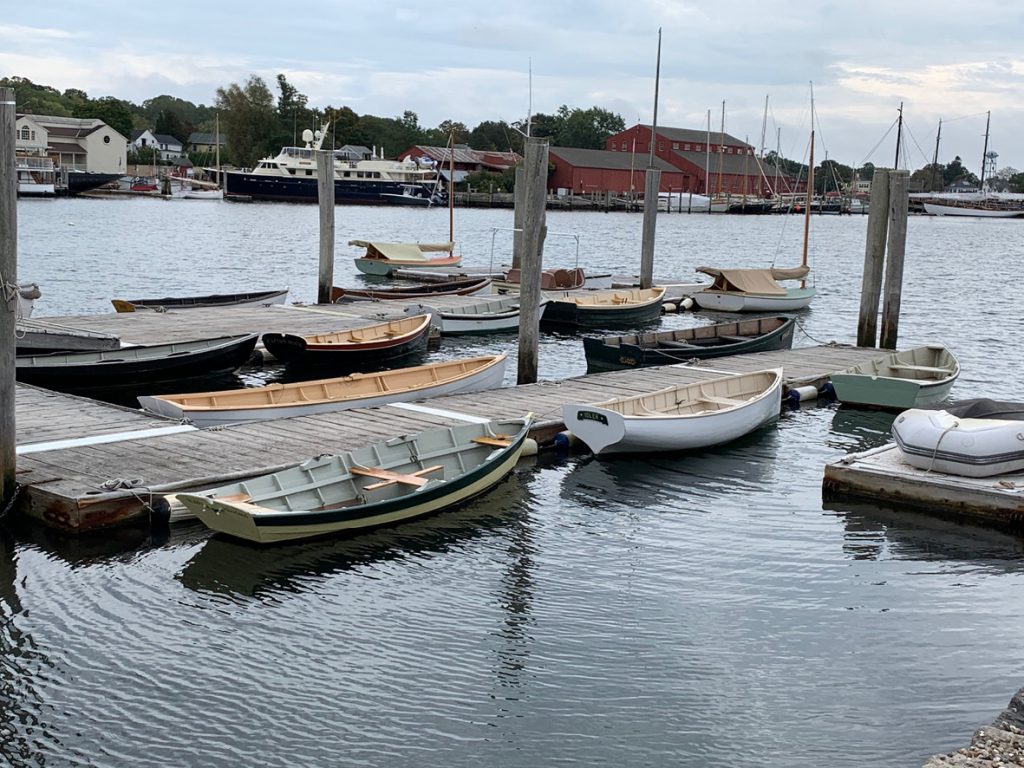
Just a few of more than 400 small boats at Mystic Seaport Museum
Story Boats: The Tales They Tell is the brainchild of MSM’s Senior Director of Museum Galleries and Senior Vice President of Curatorial Affairs, Christina Brophy, Ph.D. My podcast, Conversations with Classic Boats, is sponsored by Gowrie Group, part of the Risk Group, veteran purveyors of insurance for your watercraft. We salute Carter Gowrie and his team for getting behind this innovative new look at iconic small boats. Hear from Gowrie Group in our podcast on Story Boats as well. Tune in for Part I on May 5th at conversationswithclassicboats.com, and two weeks later for a special sequel leading up to the opening day of the exhibit. Gowrie Group is also a Corporate Sponsor of Mystic Seaport Museum.
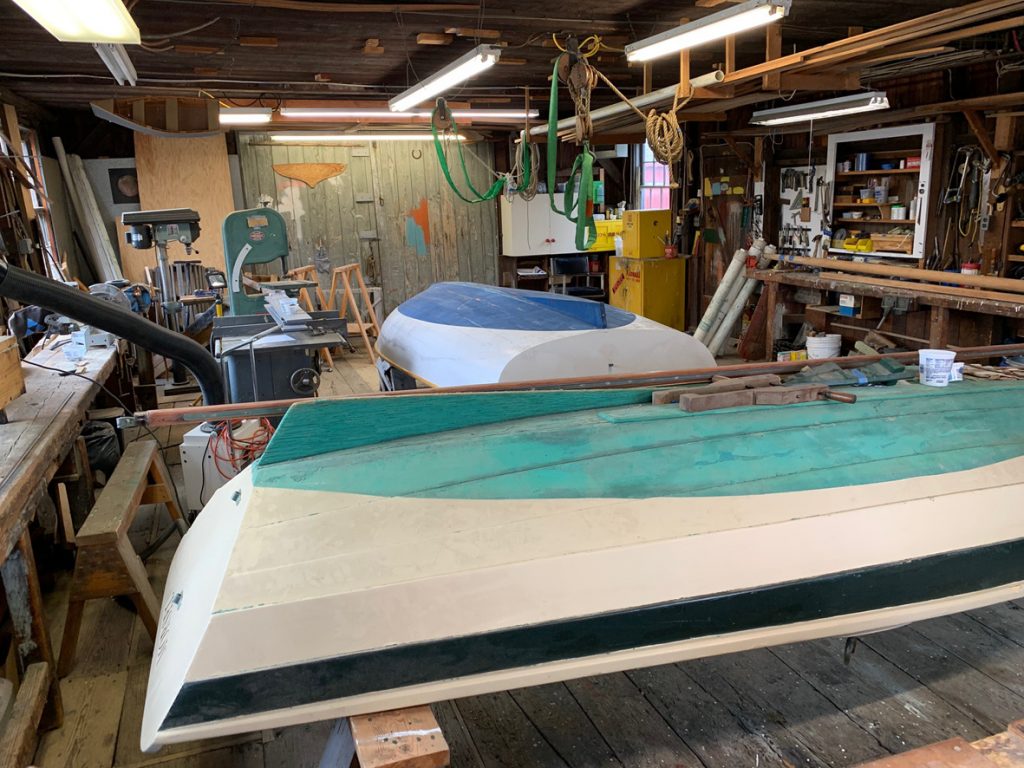
The Boat Shop at the Museum
Christina Brophy is a mariner and curator who got her sea legs on the St. George’s School vessel, Geronimo, banding turtles and inspecting sea creatures. She passed through academia on three continents, ending up in Valencia, Spain, site of the upcoming America’s Cup. At the New Bedford Whaling Museum, she curated thirty exhibitions including ones focused on maritime characters like Starling Burgess, the Stanford White of American yacht designers, and Ray Hunt, whom we have profiled as the godfather of the Boston Whaler.
When I talked to Christina, she was connecting via Zoom in the Mojave Desert. She was land sailing her compact land yacht, the Blokart, which conveniently comes apart to fly as checked luggage. She had a vision while in pandemic transition of an exhibit that would draw from the extensive watercraft collection housed across the street from the main campus of the Museum.
I have been a guest there half a dozen times, most recently for the podcast “Hickman, Hunt and the American Runabout.” This, along with three or four other Conversations with Classic Boats episodes, drew directly from the contents of the building that morphed from an operating velvet mill to a watercraft storage facility for the institution.
A distinguished succession of boat historians has supervised the small watercraft collection at MSM — a triple play comprising John Gardner to Maynard Bray to Quentin Snediker. These curators served as stewards of the collection, which over the decades has grown to more than 400 small boats.
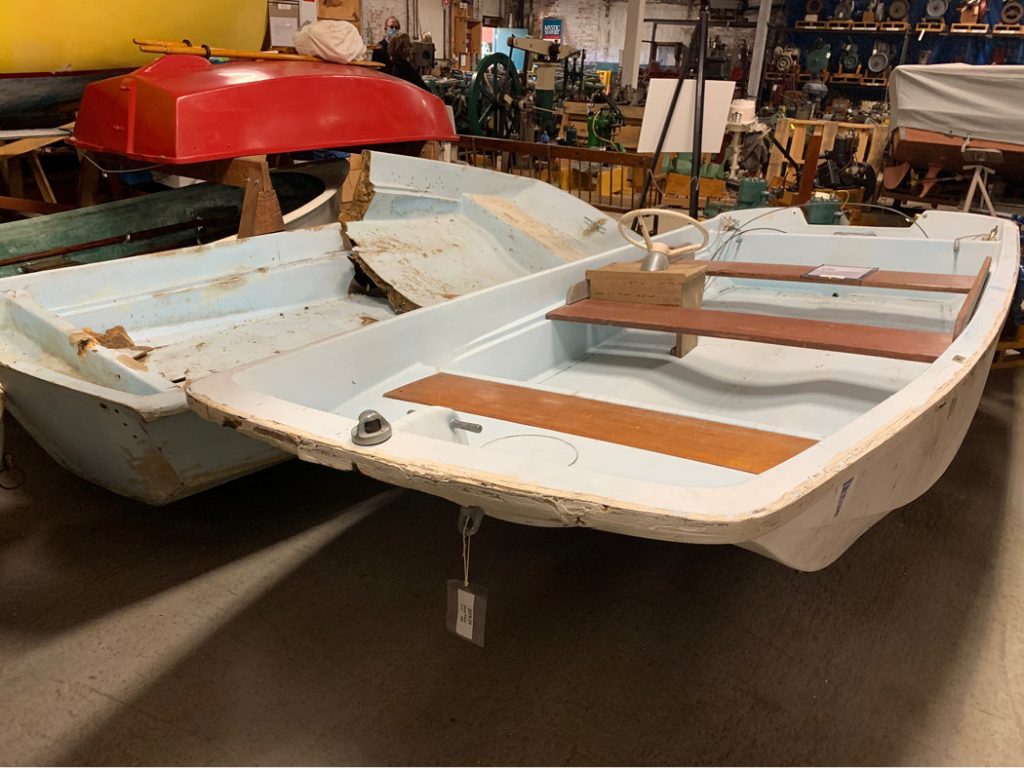
The 13-foot Boston Whaler, known as “the unsinkable sensation.”
We learned about John Gardner as the “dean of small craft studies” during a visit in 2020 for the podcast episode on the Dyer Dhow. On our way to the dock, we found a long shed with a diorama of the Mystic River. This exhibit illustrates the long historical trail of traditional boatbuilding on the Mystic River. On the wall on the left as you enter is a plaque bearing words that the Story Boats exhibit fully embraces. And I quote Gardner’s words on the wall:
“The way to preserve small craft is not to embalm them for static exhibit or to tuck them away in mothballs, but to get their reproductions out on the water, use them, wear them out and replace them anew. Treated in that way, small craft are immortal or as near immortal as anything can be. Historic small craft are for the young and old and the in-between. They are to use and enjoy, and to pass on for future generations to use and enjoy, ad infinitum. Preservation through use, in the long run, that is the only way.”
Here are the 18 “story boats” that will be on the MSM grounds from May 28 – August 18
Acadia–A Mini Transat sailboat raced solo across the Atlantic
Analuisa– A Cuban Refugee Vesse
Albatross lifeboat – Used by the survivors of a white squal
Whistling Wind iceboat – A boat that is fast, frozen fun
Blokart – a collapsible, compact way to sail on land
Oyster tonging dugout – An 1824 canoe used in the New Haven oyster industry; inspired by Native American design
L. Francis Herreshoff’s decked “dugout” canoe – An innovative canoe design
Patsy Green– Used by a couple to navigate 900 miles in 1908
Gerda III– An escape vessel used during World War II as part of the Danish Resistance
Raft representative of Steve Callahan’s Avon 6-Person Life Raft – Imagine 76 days adrift in the Atlantic Ocean
Steinbeck Boston Whaler – Nauset model treasured by the author
Whaler halves – The ingenious “unsinkable” ad from LIFE magazine
Ugiuvak (King Island) two-hole qajaq (kayak) – a seal skin qajaq used in the Bering Sea
Umiak used by John Bockstoce – Open boat used to traverse the Northwest Passage
Gramp – One of the Last of Its Kind
Tango – Ex-Navy SEAL pedals across the North Atlantic in 40 days
Vireo –Knockabout Sloop owned by FDR.
Laser #0 – The boat that launched generations of sailors…thank you, Bruce Kirby
A large team from across the Museum guided the development of the exhibit. This team includes Quentin Snediker, the Clark Senior Curator for Watercraft and former Director of the Henry B. DuPont Preservation Shipyard. From his graduation from SUNY Maritime and his initial captaincy of the Mystic Whaler, a private vessel taking guests into the environs of Block Island Sound, Quentin has three decades of experience devoted to the care and feeding of historic vessels. He has managed major projects at the Museum, including the construction of Amistad and the restoration of the Charles W. Morgan and Plimoth Patuxet’s Mayflower II.
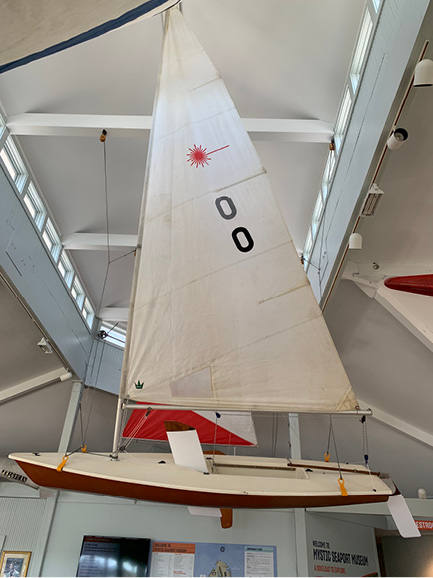
Bruce Kirby’s Laser #0, displayed in the Sanger Visitor Reception Center.
The MSM team makes full use of the expansive Thompson Exhibition Building. Some of the lighter vessels will fly suspended from the ceiling, like the Boston Whaler Halves used in the iconic “unsinkable sensation” advertising from the 1960s. Other craft will be on the gallery floor, matched with objects that help tell their stories. For example, the exhibition team places Franklin D. Roosevelt’s wheelchair with his 1912 knockabout sloop Vireo. It is believed FDR contracted polio shortly before a family trip to Campobello, where he sailed Vireo on one of the last days that he could walk without assistance.
In Part II of “Story Boats, the Podcast,” we chat with three individuals associated with vessels in the exhibit. Our last interview was local sailor and restaurateur Clay Burkhalter. Clay is the adventurer we knew best from our sailing in his homeport of Stonington and dining in his Dogwatch Café. In 2005, Clay enlisted the design expertise of his uncle Rod Johnstone to construct the 21-foot Acadia for the Mini Transat, a singlehanded race from France to Madeira to Brazil. Today’s Transat boats have foils, but fifteen years ago water ballast and enormous sprit-launched spinnakers were the new thing.
I took a ride on Acadia with Clem Wood, owner of Etisian, the rebuilt IOD featured in a recent Conversations podcast. Not much wind was there in Fishers Island Sound, but we got the idea. This was the early days of water ballast and sophisticated rigging leading to the helmsman. Far from Slocum and the Spray, this was a high-tech oceangoing jungle gym. Clay did his rigorous pre-race qualifiers and finished 13th in the 2007 Mini Transat.
My first interview was Steve Callahan, the author of Adrift: 76 Days Lost at Sea, a New York Times bestseller documenting a sinking at sea off the Canaries in 1982. Callahan survived two and a half months at sea alone in an Avon six-person life raft. I was reminded that wandering the sea alone, by accident or on purpose, is a literary spark for many. Steve had given MSM a collection of materials, some of which will be shown in the exhibition. He told me his four requirements for sea survival were: “Pad and pencil, rope and knife.” The Avon six-person raft from the incident is not in the exhibit, but visitors will be able to view and climb into a very similar raft by Avon.
My middle subject had by far the strangest craft. Dwight Collins had a childhood dream to cross the ocean. He did it in a highly unusual way: pedaling. In my discussion with Dwight, this former Navy SEAL showed a steely precision with his recollection of his 40-day voyage and an ongoing reverence for the designer of his craft, the late Bruce Kirby. Kirby pulled out all the stops in designing a combination of vessel, drivetrain and propeller to create a bright orange watertight platform that Collins propelled from Newfoundland to Plymouth, England. For those of you who have pedaled craft off the boardwalk of a seaside pond or some amusement park, imagine keeping it up for twelve plus hours a day for forty days. There are other big ideas associated with Story Boats. Each watercraft is accompanied by artifacts speaking to the voyage, intended to immerse the viewer in the story.
Another project underway at the Museum is the revival of academic publishing. There is a plan to reissue the 1970s vintage Mystic Seaport Watercraft, a 396-page tome that I have worn out as a research source during the pandemic. The final attraction of Story Boats will be the glossy souvenir book featuring photo gems of the boats. The exhibit team hopes that Story Boats will encourage visitors to find and tell their own boat stories – from bathtub toy boats to fishing kayaks, sailboats and beyond. What’s your boat story?
Visit mysticseaport.org for more details about the Museum and upcoming exhibitions and programs.
The next Conversations with Classic Boats podcast, Episode 22,
Part I: “Story Boats: The Tales They Tell: The Curator’s Cut,”
posts May 5.
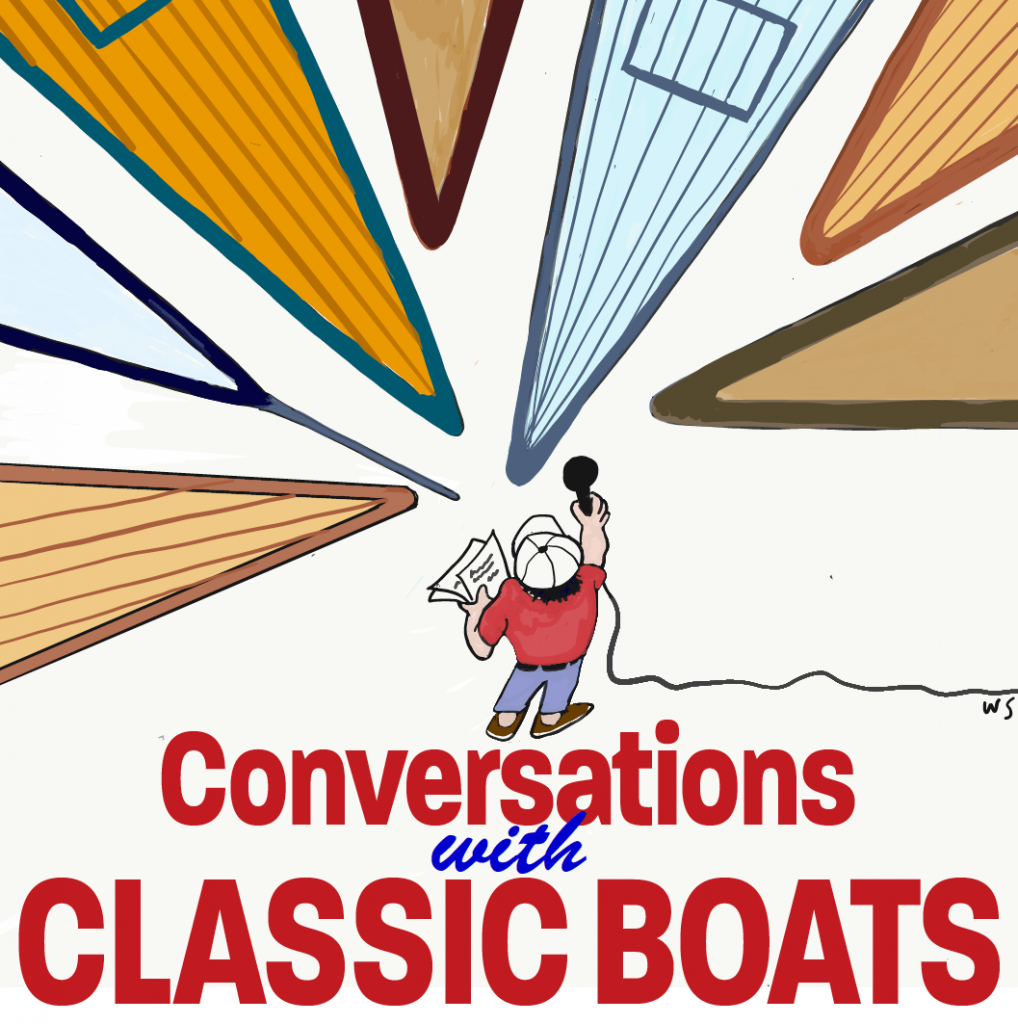
Tom Darling is the host of Conversations with Classic Boats, “the podcast that talks to boats.” Tune in via Apple Podcast, Google Podcast or Spotify, or online at conversationswithclassicboats.com.

Scan here to learn more about Mystic Seaport Museum’s Story Boats exhibit.
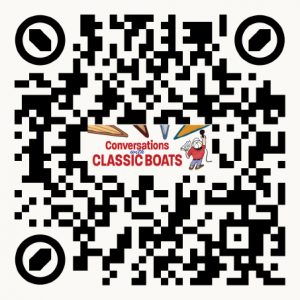
Scan here to tune into the author’s Conversations with Classic Boats podcast.
